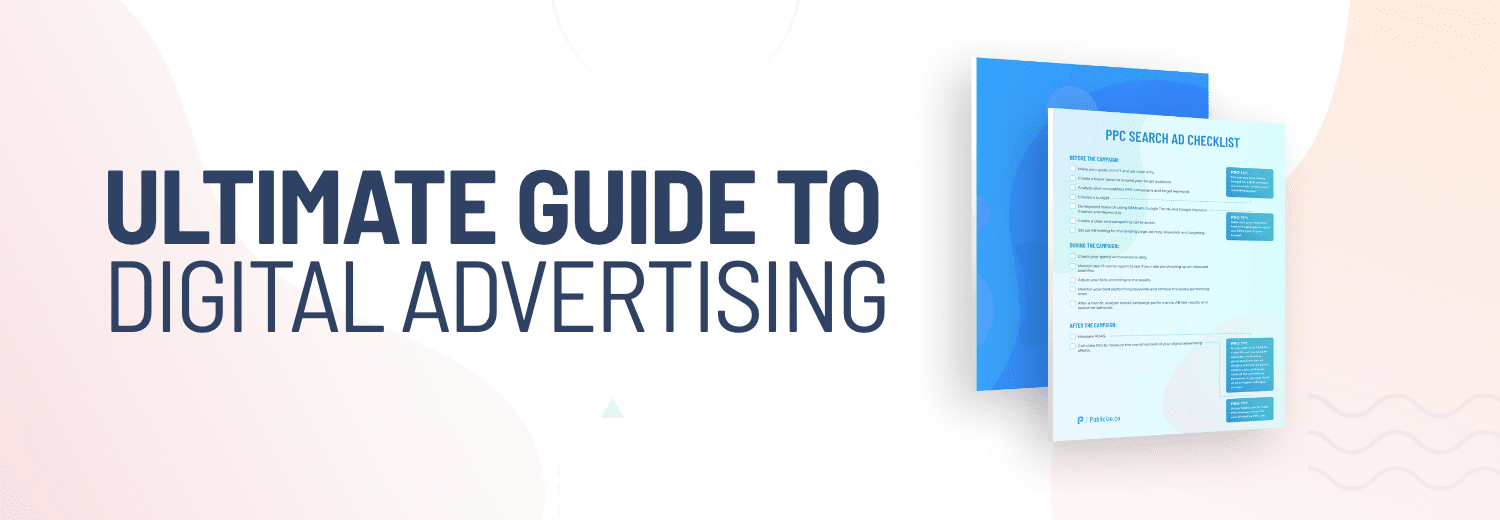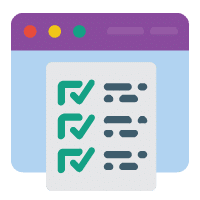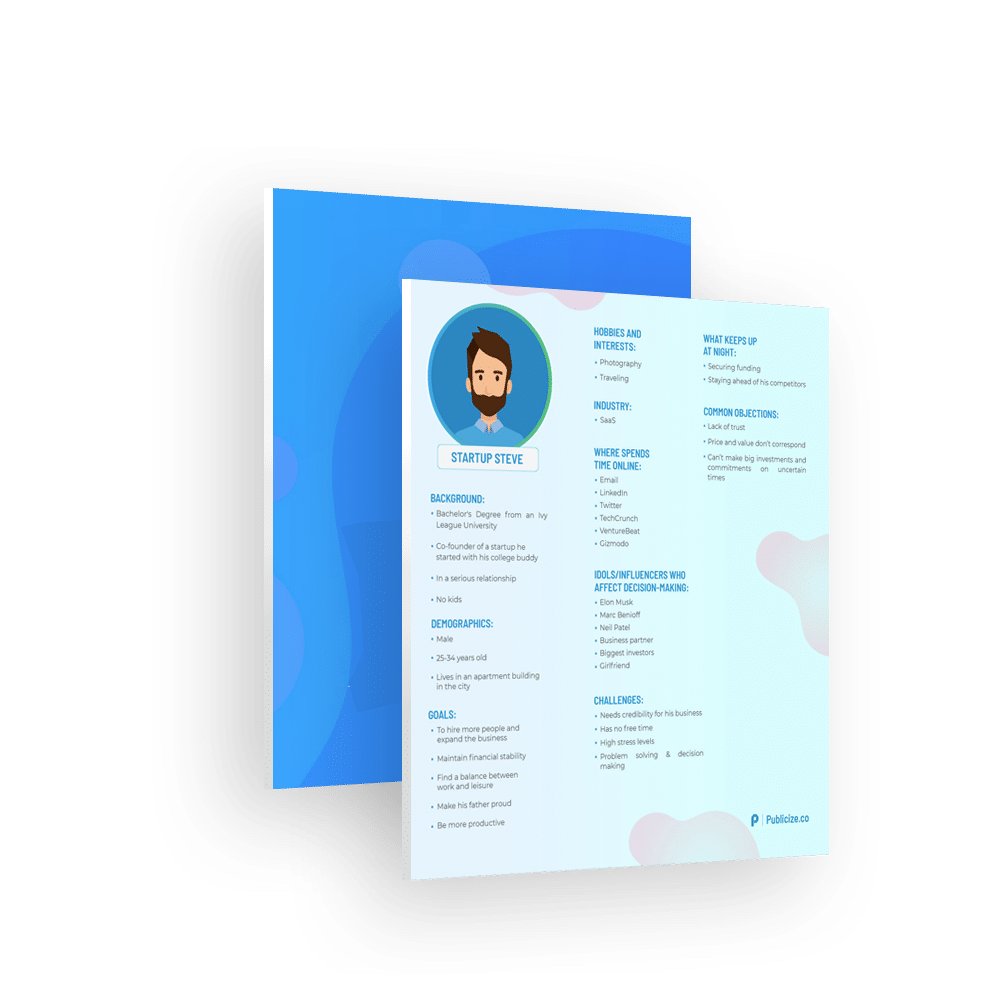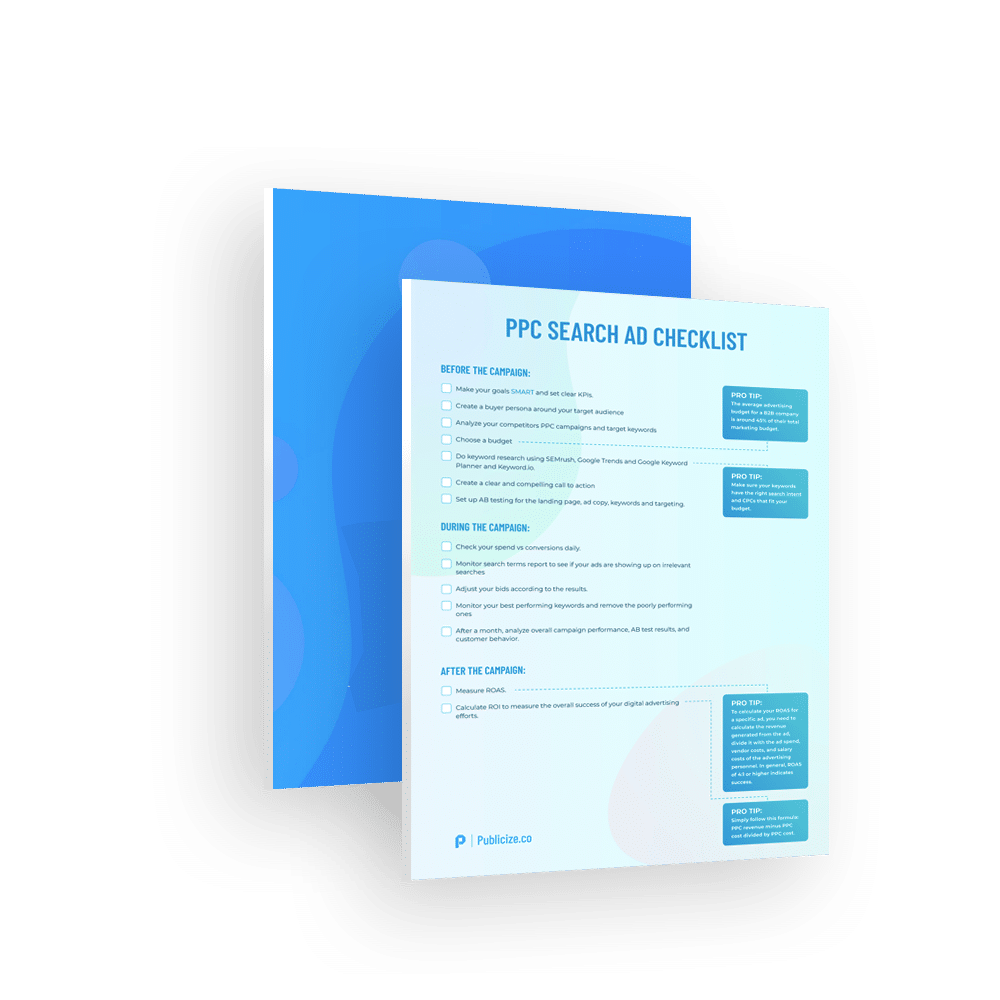We’ve collected the best advertising tips and actionable insights from our digital advertising experts to help you elevate your ad campaigns and boost your company’s growth.
This comprehensive guide will help you to set up an effective digital advertising campaign, choose the relevant methods and learn the best practices for digital advertising in 2021.
Let’s get started with a digital advertising definition.
What is digital advertising?
In a nutshell, digital advertising is paid media. It uses different internet platforms such as social media, email, search engines, mobile apps, and websites to send promotional messages to a target audience.
Different types of digital advertising are search engine marketing, display advertising, social media advertising and native advertising, which we’ll get into later in this guide.
How to start a digital advertising campaign
- Set your advertising goals
Defining your paid media goals determines the wireframe for your entire ads campaign. Take the customer journey stage, touch points and your KPIs into consideration before you begin designing or building your ads.
Not sure what your goals are, where they lie on the customer journey or what KPIs to measure? We’ve got you covered:
Awareness Stage:
Goal: Increase awareness
KPIs: Reach, clicks, CTR (click-through rate)
Consideration Stage:
Goal: Generate high-quality leads
KPIs: Content downloads, trial signups, newsletter signups
Purchase Stage:
Goal: Increase revenue
KPIs: Sales call bookings, sales opportunity ratings
- Choose what you want to promote
Knowing what you want to advertise links nicely with our first step, as whatever you promote should directly relate to your goal. Let’s say you’re a SaaS company with a goal to generate high-quality leads. An ad that’s relevant to your goal would be, for example, promoting a free trial. Unsure what this would look like?
Here’s a great example from SaaS company SEMrush:
3. Identify your target audience and research where to find them
Creating a buyer persona is a great way to understand your audience’s demographics, pain points, goals, common objections and interests.
Buyer personas will also help you determine which advertising platforms and methods are the most relevant for your audience.
PRO TIP: Ad targeting
76% of advertisers fail to use behavioral data for online ad targeting. Conducting a behavioral analysis on your target audience helps you optimize your ads to better suit your audience. Combining this with AB testing is the best way to optimize your ad targeting.
4. Choose a budget and determine campaign length
The next step is allocating an ads budget. The average advertising budget for a B2B company is around 45% of their total marketing budget. However, you should decide the type of ads you want to focus on and the average Cost-per-click (CPC) before you pick a number.
For example, PPC ads are more expensive than display ads and different industries have different average CPCs. Average CPC for B2B keywords is $1.64 while legal industry has the average CPC of $5.88.
Once your budget is clear, you need to decide the right campaign length. For example, finding out peak times for your target audience’s engagement during the week – using tools like Google Analytics and Google Ads – will help you optimize the way you manage your ads campaigns.
5. Create your ads
Whether you choose a video, text, photo, audio ad- or all together, you need to make sure you pick the most relevant ad formats for your objectives and your audience.
PRO TIP: Landing page & AB testing
If you manage to design a click-worthy ad, your job is only halfway done. Creating a fast-loading and mobile friendly landing page with an easy-to-follow user experience and a clear and compelling CTA plays a crucial role for converting the clicks to sales.
Better user experience as a result of AB testing can increase a company’s conversion rate by as much as 400 percent. However, only 17% of marketers are taking advantage of this. To leverage AB testing for your campaign, you should test your landing page, but also the ad format, copywriting, landing page, CTA, keywords, and ad design.
6. Set clear KPI’s and monitor results
To determine the success of your ads campaign, make sure you establish KPIs that are achievable, measurable and relevant.
Monitoring results, conducting regular ads audits and analyzing behavioral data will help you understand which areas in your campaign need improvement.
Depending on your advertising campaign goals, you need to focus on specific metrics and make strategic optimizations throughout the campaign to reach your KPIs. If you’re unsure where to start with KPIs, take a look at our list of important digital advertising metrics:
Conversion rate (CVR) — CVR is the ratio between clicks and conversions. The average CVR rate for digital ads varies between industries, but generally stays between 2-10%.
Cost-per-conversion (CPA) — CPA measures an estimate of how much every new client is costing you. It’s calculated by dividing the cost of conversions by the number of conversions.
Cost-per-click (CPC) — CPC is the amount that you pay each time your ad is clicked.
Click-through rate (CTR) — CTR is the ratio between impressions and clicks on ads. Average for a successful CTR is around 2%.
The best free tools to measure these metrics are Google Analytics, Firebase & Flurry.
PRO TIP: Calculate ROAS
Where ROI looks at the success of the entire project, ROAS focuses on the success of specific ads, or campaigns and only considers advertising costs. ROAS can give you useful insights that you might miss just by focusing on individual metrics and ROI.
To calculate your ROAS for a specific ad, you need to calculate the revenue generated from the ad, divide it with the ad spend, vendor costs, and salary costs of the advertising personnel. In general, ROAS of 4:1 or higher indicates success.
Search Engine Marketing (SEM)
Search Engine Marking (SEM) uses paid advertising tactics to appear on top of the search queries.
Depending on budget and audience, SEM strategies are generally focused on Google Ads, as Google’s search engine receives 92.54% of all internet searches, the next biggest being Bing with only 2.44%.
SEM leverages PPC (pay-per-click) search text ads and visual google shopping ads.
SEM vs SEO
In a nutshell, an SEM strategy is a paid and an SEO strategy is an organic. Both share the same goal — to appear in the relevant search engine result pages. What makes them different is that SEO results are achieved by time-consuming keyword optimization and content creation, building a backlink profile and increasing DA, whereas paid results are achieved by less work but higher cost.
PPC
As suggested by the name, pay-per-click or PPC ads require that you pay a certain amount for each click your ad receives, known as CPC (Cost-per-click). PPC is most commonly used for SEM but it has been adopted for other types of advertising as well.
PPC advertising enables you to reach your target audience on search engines without having to spend countless hours building this exposure organically.
Research shows, in fact, that visitors who click PPC ads are 50% more likely to convert than organic visitors. Advertisers average an $8 profit for every dollar spent on Google Ads, making PPC advertising lucrative if used effectively.
When setting up your PPC campaign on Google Ads, begin by finding the most relevant search queries you want to appear on from your keyword research.
SEM keyword research
Keyword research is the cornerstone of a successful PPC search ad campaign.
As a base rule, high-volume and low-competition keywords with CPCs that fit your budget are the ones you want to aim for. However, the keyword search intent needs to correspond with your advertising objective.
Targeting descriptive long-tail keywords is a good way to achieve better conversion rates and manage the campaign costs. These keywords have lower search volume but more affordable CPC’s and lower keyword difficulty (KD).
Negative keywords, the irrelevant keywords that you don’t want your ad to show up for, also play an important role when setting up your ad campaign. They help you control the costs and keep your targeting as relevant as possible.
This ad example from Snickers cleverly used keyword research to target common misspelled words in its SEM campaign.
Best SEM keyword research tools
Ad auction
So, you’ve decided which keywords your SEM ads campaign’s going to focus on.
It’s time to go to auction.
Google’s ads auctions determine whether your ad’s eligibility and rank for a given search query.
Firstly, ad auction assess eligibility by your maximum bid – how much you’re willing to pay per click. After this, your quality score – which is calculated based on your relevance to the keyword, expected CTR and the landing page experience – is considered.
After the auction is finalised, your search campaign is ready to launch.
PRO TIP: Google has a variety of different ad extensions you can use to increase the conversions of your search ad campaign. Depending on your goals, you can either add location, sitelink, call or other extensions to your ads.
Digital display advertising
Display ads are image-based and video-based ads on display advertising networks like Google Display Network and Facebook.
Display ads are placed on relevant websites in the form of banner, image, text, or interstitial pages.
‘Banner blindness’ and increased use of AdBlockers create a challenge for brands to succeed with display ad campaigns. Despite this challenge, there are still effective ways to leverage display advertising.
Retargeted display ads
Only 2% of website visitors end up completing a purchase on their first visit to your site.
Retargeting is a strategic way to remind the rest of the 98% of shoppers of any pending interest, and bring them back to your site to complete the purchase.
Retargeted ads are an effective way to hyper-target your audience and increase conversion rates. Research shows that retargeting increases users purchasing intent by 70% and the CPCs are generally more affordable in comparison to PPC search ads.
A creative software company Adobe is a great example of leveraging retargeted display ads with eye-catching visuals, compelling copy and more informed audience targeting by collecting user data from multiple different sources.
Retargeting vs remarketing
The difference between retargeting and remarketing can be confusing as they’re often used as synonyms. They both have the same goal, for example – to convert a former site visitor into a customer.
The best way to differentiate these two is by their methods.
Retargeting mainly works with display or native ads via browser cookies. Remarketing, on the other hand, works mostly through email. A campaign that uses both methods is often called remarketing campaign as an umbrella term.
Mobile advertising
As mobile accounts already for 50% of all web traffic, mobile advertising is becoming increasingly popular.
Mobile advertising is best suited to ads that are mobile optimized or text ads through SMS.
There’s a number of ways you can do mobile advertising, be it click-to-call ads, click-to-message ads or click-to-download ads. Push notifications, advertising within specific apps and using rewarded video ads like “watch this video and use the app for free” can be effective mobile advertising methods.
Rewarded video has been particularly effective with mobile games. For example, internet game developer 5agame made 80% of their revenue from rewarded videos.
Mobile advertising is not only about just targeting smartphone users. It’s assuring that all ads that you’re running are mobile friendly and optimized for all screen sizes.
There are many ways to get creative with mobile advertising. A great example of this is a mobile ad from Netflix that is mimicking its hit series Black Mirror.
Programmatic digital advertising
Programmatic advertising is when buying and selling online ads is automated.
Its ability to make advertising more efficient leaves more time for advertisers to focus on ad optimisation and improvements. Programmatic advertising buys ad space based on algorithms, consolidating all ad campaigns on one platform.
Once you’ve chosen the right programmatic ad platform, you’re one step closer to more efficient advertising.
It should be said, however, that swapping human judgement for an algorithm has its own issues. A few years back, Youtube got itself in trouble with its clients by showing their ads on videos promoting hate speech and other questionable content.
So, when relying on programmatic advertising, make sure you keep monitoring where your ads end up.
Social media advertising
Social media advertising campaigns run on social media platforms like LinkedIn, Facebook, Twitter, Instagram, Youtube and Tik Tok.
Studies show that businesses which include social media into their digital advertising campaigns have 129% higher conversion rates. As well as this, social media ads have advanced targeting options and a variety of different ad options from messenger ads to display and native ads.
However, to leverage social media advertising, first you need to know which platform your audience is using.
Facebook: Facebook has the widest reach and a large variety of advertising options from different display ads to native and messenger ads along with more advanced targeting options compared to other social platforms. For example, the founder of Consulting.com coaching business leveraged facebook ads to grow a million dollar business with engaging ad copy and authentic storytelling.
Instagram: Instagram ad options are similar to Facebook, and you can manage ads for both through the same interface. Facebook might have the most users, but Instagram defeats Facebook in engagement, by having 58% higher engagement rate. It’s also the most popular social platform for influencer marketing. Instagram allows you to run ads in the news feed, explore tabs and stories.
Twitter: Twitter offers a variety of different campaign options such as promoted accounts, trends, website cards and hashtags. Twitter is popular among B2B advertising and among those businesses with older and sophisticated target audiences. Twitter advertising can be very effective as 90% of users read the ad copy and spend more time reading the ads than on any other platform. However, if you’re planning to advertise on Twitter, remember when in Rome, do as the Romans do and keep your ad copy concise.
LinkedIn: LinkedIn is where you find the highest average disposable income, with 75% of LinkedIn users earning more than $50,000 per year. It’s also where you tend to find the highest quality leads. Advertising on LinkedIn can be very profitable for B2B companies as the ads have the ability to target by company, company size, title, location, seniority, age, education and skills. The types of ads in LinkedIn are sponsored content, sponsored InMail and text ads.
Youtube: With over 3 billion searches per month, Youtube is now the second largest search engine in the world. As 80% of shoppers who watch a YouTube video related to a purchase they’re planning end up buying, it’s a platform that you don’t want to ignore. Youtube advertising offers a wide variety of ads from different length videos in the beginning and middle of the Youtube video and display ads and the homepage.
TikTok: TikTok is the newest player in the social media game that calls itself the “destination for short-form mobile videos.” With over 800 million monthly active users, TikTok advertising is gaining more ground especially with companies whose target audience is under the age of 30. TikTok offers several options for advertisers such as in feed video, hashtag challenge, brand takeover, and branded AR content.
Influencer Marketing
According to studies, 63% of consumers trust influencer promotion more than brands directly promoting themselves.
Statistics like these show that when talking about social media advertising, it’s important not to forget influencer marketing. Leveraging the audience of an influencer who has built a strong brand reputation in your niche to promote your company is an effective way to advertise, especially when your company is B2C. As for B2B companies, micro-influencers prove themselves to be effective at increasing brand awareness and cementing industry credibility. Software developer pioneer IBM, for example, became the trailblazers of employee advocacy by using their own employees as influencers.
Native Advertising
Have you ever accidentally clicked on an ad because you confused it with organic content?
Welcome to native advertising.
Native ads are paid content such as articles, videos and visuals produced by a known publisher. What makes native ads different from other ads is that they mimic organic content by following the style and editorial tone of a site or brand.
Native Advertising is a clever way advertisers have overcome the problem of banner blindness and the increasing number of ad blockers. Native ads are made to be non-disruptive, matching the look and function of the media platform they appear on. They must say “ad”, “sponsored” or “paid” on the ad so they can be recognized as paid media.
Here’s a great example of a native ad from AirBnb using the New York Times as a platform for its advertising.
Wrapping Up
Effective online advertising is all about knowing your business goals, who your audience is and the tools you need to build a successful campaign.
This, with some diligent monitoring of user behavior data, will allow you to reap the various benefits of wider reach, increased traffic and improved conversion rates from digital ads.
An ads strategy that constantly evolves to meet its buyer persona’s needs is your sharpest tool for cutting through the mass of mediocre paid media. Follow this guide and when the warm leads begin rolling in – and the revenue starts piling up – you’ll realize that digital ads should be the centerpiece and not the sidekick of your overarching marketing strategy.











